Aptos threads designed for reinforcement are a new modern technique that allows a woman to preserve her natural beauty longer. It consists in creating a metal frame that fixes the facial tissues and provides them with support. This method of rejuvenation was invented by doctor Sulamanidze, who back in the 90s patented this method of bioreinforcement. At the moment, such reinforcement is used in almost fifty countries. There are many positive and negative reviews of this rejuvenation method on the Internet, let’s try to understand them.
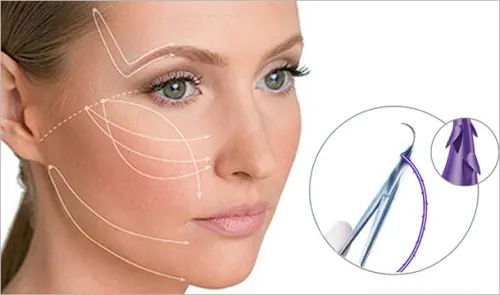
What is this Aptos thread procedure?
If we compare Aptos threads for lifting with surgical plastic surgery, then this is a method of rejuvenation that does not leave scars and stitches on the face. It does not involve the deep layers of the skin, there are no scars and there are practically no contraindications for patients.
Each thread has a length from two to nine centimeters. The procedure itself is carried out using either mesothreads or Aptos threads. Mesothreads are inserted under the skin of the face, and after some time they dissolve. But during this time, collagen grows on them and creates a natural frame. When the threads have dissolved, the frame itself remains intact, and the contour of the face is the same as at the beginning of the rejuvenation period. In order to understand which is better, you need to know their differences.
Mesothreads come in three types:
- linear;
- needle-shaped;
- spiral.
They also have different compositions:
- from caprolac;
- from polydioxanone.
Cosmetologists claim that if the client is insensitive to Botox, then using mesothreads will bring good results and strengthen the facial contour.
Aptos threads do not dissolve, unlike mesothreads. In addition to the facial contour, the procedure is carried out in the hips, neck and décolleté. Most often, bioreinforcement is carried out when creams and lotions do not give the desired result, but the patient is not ready for surgical intervention. Nowadays, thread lifting has improved so much that it can be done simply in a cosmetology office.
Benefits of a facelift with Aptos threads
The advantages of Aptos threads are obvious:
- short recovery period,
- absence of surgery as such,
- after the procedure there are no noticeable scars or puncture marks,
- do not excise areas of skin,
- the effect of bioreinforcement lasts up to five years,
- The lift is done under local anesthesia,
- there is no need to stay in the hospital, the patient can go home immediately after the procedure,
- the risk of infection is minimized,
- minimal tissue trauma,
- the patient can choose the type of threads for the procedure,
- Thanks to this lift, very deep wrinkles are eliminated, and the facial contour becomes clearer,
- Aptos threads go well with other hardware procedures for skin rejuvenation,
- when the threads are introduced, they do not affect the aging or deterioration of the skin,
- if the threads are inserted correctly, they do not cause any inflammation or rotting under the skin,
- an experienced specialist can carry out the procedure in such a way that the threads will not be noticeable at all and the rejuvenation effect will be maximum,
- Aptos threads are placed a maximum of three millimeters deep into the skin, thus minimizing the risk of touching blood vessels or nerve endings,
- after a facelift, the skin will not be stretched as much as after other procedures, and there will be no doll effect.
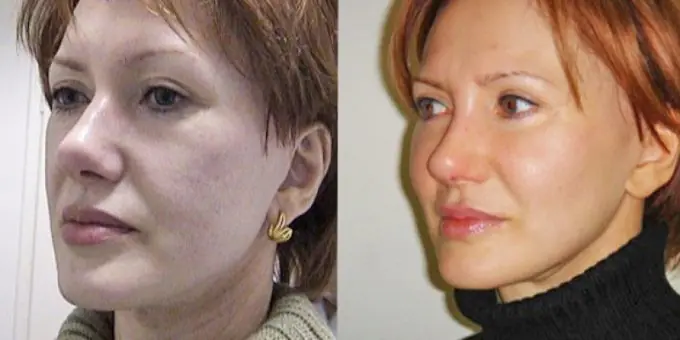
Disadvantages of braces
Among the negative aspects of using the procedure are:
expensive payment for the procedure;
- a very large number of contraindications for the procedure;
- side effects exist even with the slightest damage to the skin;
- there is a possibility of not achieving the desired result;
- repeating the procedure several years later.
What does the result of the procedure depend on?
In general, how good the result of a facelift will be depends on the following factors:
- the patient’s health status, as well as following the cosmetologist’s instructions before the operation;
- contraindications to the use of the procedure before it is carried out (the appearance of negative
- the consequences increase significantly if there was even the slightest contraindication);
- the experience and qualifications of the cosmetologist who will perform the facelift;
- choosing the right threads specifically for your body;
- sterility during bioreinforcement.
The first results can be seen within a few days, but the final results will only be seen after almost a month. It takes time for the skin to get used to foreign bodies, and also for the threads to become at least a little overgrown with natural collagen.
Types of threads
Doctors use several types of threads, selecting them according to the indications and age of the client.
Aptos surgical threads. Their second name is non-absorbable. They are made from polypropylene. The introduction is carried out with a slight indentation and does not affect the deep layers of the skin. With their help, a frame is formed, but it does not affect the nerve endings and blood vessels. Such threads can be smooth or notched for additional fixation. They are used for pronounced ptosis and nasolabial folds. Placed in the chin area, the upper eyelids are lifted. Duration of effect: 60 months.

Threads with subsequent resorption or biodegradable. They are made from caprolac with L-lactic acid. They have notches for tissue fixation. The most famous manufacturer: Excellence. This material is also called biofilaments. The result lasts up to 24 months.
APTOS Needles are used only for surgical operations because they are firmly fixed and do not dissolve. If they are used for skin tightening, they are usually injected into areas where hair grows. Most often, this type of Aptos thread is indicated for patients with age-related changes after 50 years. The second generation threads are marked 2G, which differs in the way the threads are installed.
Age for lifting
When can you install Aptos threads? The condition of the patient’s skin is determined by the doctor, because the skin of people of the same age may differ. Before the age of forty, the doctor places both types of threads (with or without resorption). The type of materials used depends on the areas where they are installed.
At the age of up to fifty years, threads are placed without resorption. Their design helps the doctor to tighten the skin after reinforcement. If the patient is over 50 years old, it is recommended to insert threads without resorption. The skin is cut to a length of 0.5 cm, and such incisions are made behind the ears or in the scalp, that is, in those places where it is not visible.
Contraindications
The Aptos lift is recommended if the patient’s facial contour begins to lose definition and a double chin appears. Thread lifting is used and in cases where the skin's elasticity is impaired, lumpiness appears. Threads are placed when jowls form (sagging cheek skin). Often the indication for a client may be drooping of the lower eyelid, lips or eyebrows.
This type of reinforcement is used if the skin begins to deform from scars or the patient has noticeable facial asymmetry (from birth or acquired). For deep nasolabial folds and forehead wrinkles, thread lifting is also recommended. If there is sagging skin in different areas, then doctors also recommend this procedure.
Who should not have a lift?
Despite the fact that the Aptos facelift is considered not too traumatic to the skin, there are a number of patients for whom it is contraindicated:
- Acute stages of chronic diseases
- Vascular pathologies and heart diseases
- Acute respiratory viral infection
- Skin cancer
- Inflammatory process on the skin
- Pregnancy
- Lactation
- Presence or tendency to develop keloid scars
- Poor blood clotting
- Implants made by injection
Carrying out the procedure
No special preparation is required to perform the operation. To avoid complications and excessive blood loss, the patient stops using blood thinners 7 days before the tightening.
Installation of threads is done over a period of 10–30 minutes. The reinforced frame can be installed in the eyebrows, cheekbones or other areas. When installed in several zones, the procedure can last from one and a half to two and a half hours. Only those areas where bioreinforcement will be performed are anesthetized. The Aptos thread procedure is not performed under general anesthesia.
The doctor makes small punctures (cuts) in the skin. If the effect is carried out inside the dermis, then needles with suture material (cannulas) are inserted into it. This is a material with notches that open into the tissue after installation and help create a frame. Over time, collagen fibers grow on the threads, making the skin denser. The threads tighten the skin. The incisions are made so that they are not visible and there are no scars left on the face. The doctor produces them in the scalp. The lifting effect is visible after 4 weeks, and it lasts for a period of 3 to 5 years.
Rehabilitation period
The procedure is performed by a cosmetologist or in a clinic by a surgeon. Although it does not cause severe blood loss and does not cause serious complications, the patient will require long-term hospitalization. Time takes from 14 days to a month. After the threads are placed, the patient may experience hematomas, swelling, and possible skin unevenness. After a few days, these symptoms disappear.
You cannot massage this area for a week, and it is recommended to sleep on your back and stomach. It is strictly forbidden to sleep on your side, go to the bathhouse, or sunbathe. Patients are advised to refrain from active facial expressions and not engage in physical exercise during the recovery period.
Chew food carefully; it is better to take liquid food. It shouldn't be hot. Incisions should be treated with an antiseptic solution up to 3 times a day. Cold is applied to them. You should not hold the ice for a long time, so as not to chill the skin or blood vessels. It is enough to keep the ice compresses on for five minutes.
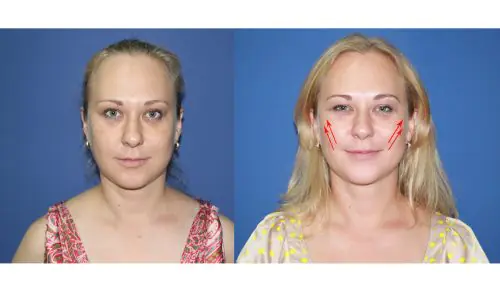
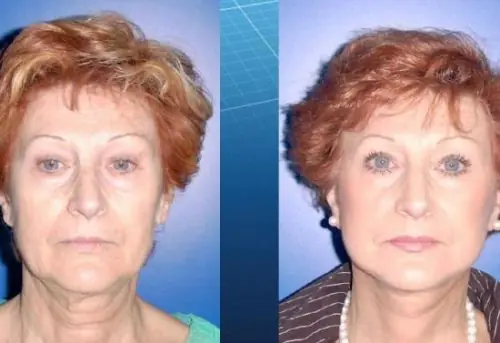
In order for the hematomas to disappear faster, it is necessary to use Lyoton and Troxevasin ointments. And if there is severe pain after the procedure, the doctor recommends taking anesthetics. Rapid healing procedures are recommended, such as ultrasound or hyaluronic acid-based masks.
Complications after the procedure
Bioreinforcement is considered a low-traumatic procedure, but in some cases complications are possible. Much depends not only on the professionalism of the doctor, but also on the individual characteristics of the person and the quality of the material implanted under the skin.
- Suppuration after administration. In these cases, the patient is prescribed a course of antibiotics.
- Possible thread exposure. This happens every tenth procedure. The risk group includes women with thin skin and those people who have very developed facial expressions. The doctor simply trims the ends of the reinforcing threads.
- The face may become asymmetrical. Most often, such complications begin due to polypropylene threads, which are needed to tighten sagging facial skin. The risks increase if several threads are inserted into one puncture at once; liquid threads for the face can help.
- Problems with facial expressions and skin sensitivity. With such a side effect, as a rule, the threads are removed.
- You can see the installed threads under the skin. This usually occurs if the patient has very thin skin and the threads are placed close to the surface. After 2–3 months, this translucent effect disappears as it becomes overgrown with connective tissue.
- Violation of the relief of the skin. You can adjust Aptos threads manually. Sometimes it is necessary to supplement the reinforcement with plastic surgery of facial contours or botulinum therapy.
- Chronic inflammation around punctures that does not stop. The doctor removes the threads to remove the suppuration.
- Hematomas under the skin after surgery. They happen when the vessels are located close to the surface.
- Pain after the procedure. The doctor recommends taking anesthetics.
- Weakening. The doctor corrects the reinforcing frame 3 months after bioreinforcement. After this, the face looks young, elastic and toned.

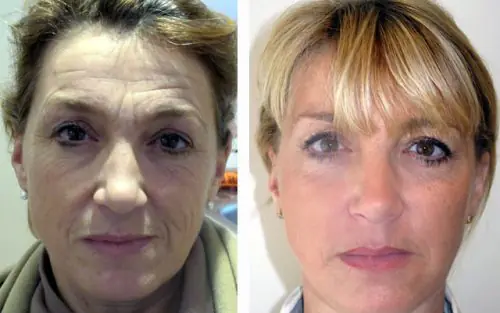
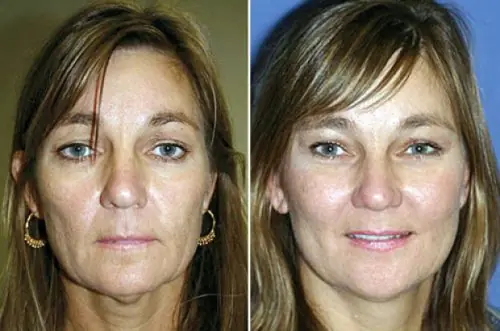
Facial care after the procedure
After a facelift, it is necessary to treat the skin with antiseptic agents in order to prevent suppuration of the wounds. If the skin of the face is inflamed, then it is necessary to wipe it with chamomile decoction, it must be frozen into cubes. Chamomile perfectly relieves inflammation, itching and pain.
The first week is prohibited from applying any cream.
on the face, and after seven days you can make masks from natural ingredients (yolk, honey, cream, starch).
In order for the effect of the procedure to be maximum and painless, you need to listen to the advice of a cosmetologist. Both before the lift and after during the rehabilitation period. The human face requires very delicate care, and is extremely demanding during correction. Therefore, the choice of clinic is a very important factor. If you have already decided to have a facelift, then you definitely shouldn’t save money. Saving money can play a very cruel joke and negatively affect both the appearance of the face and the overall health of a woman.
After introducing threads under the skin, the skin does not fade, and wrinkles become less noticeable. After the procedure, the skin does not restore its appearance immediately, but in the third or fourth week after the operation. The effect is long-term: from 2 to 5 years.
Using this technique, a frame is made, it moves, and then, thanks to notches, it is fixed in the right place. After installing the threads, the tissues subjected to correction do not move, but remain motionless. Doctors use several types of threads for the procedure. They are individually selected for each patient. Their type depends on the client’s age, depth of wrinkles and other features.
WARNING!
Please read this memo carefully. Here you will find important recommendations and answers to frequently asked questions regarding the Aptos thread implantation procedure. If you have any additional questions, you can contact our specialists.
Indications for use
- Initial or moderate manifestations of age-related changes in the soft tissues of the face.
- Mild to moderate signs of skin laxity.
- Drooping or drooping of the eyebrow, or only its outer third.
- Sagging of the cheek-zygomatic area, nasolabial folds and jowls, the appearance of “marionette lines”.
- Deformation of the oval face, appearance of a double chin.
- Age-related changes in the neck.
- Atrophic changes and uneven relief of the skin and subcutaneous tissues
- Facial asymmetry.
Contraindications
Absolute
- 4th degree of gravitational ptosis of the soft tissues of the face (presence of pronounced excess facial skin).
- Severe atony of the skin.
- Acute inflammatory diseases in the intervention area.
- ARVI.
- Exacerbation of chronic diseases.
- Hemophilia, bleeding disorders.
- Polyvalent allergy.
- Oncological diseases in the acute phase, period of chemotherapy, radiation therapy.
- Acute inflammatory diseases of the oral cavity.
- Acute inflammatory diseases of the ENT organs.
- Decompensated systemic and autoimmune diseases (Sjögren's disease, scleroderma, Tsumbusha lichen sclerosus, SLE, etc.).
- HIV infection, Viral hepatitis.
- Decompensated diabetes mellitus.
- Menstruation 1 week cycle.
- Pregnancy, lactation.
- Previously introduced non-biodegradable shellless implants in the intervention area (PAAG, silicone, petroleum jelly, biopolymer).
Relative
- Arterial hypertension above grade 2.
- IHD above 2FC.
- Taking anticoagulants, antiplatelet agents.*
- Xerosis, “tissue paper” symptom.**
- Moderate skin atony.**
- Darmatoporosis.**
- Hyperkinesis.**
- Grade 3 gravitational ptosis of soft tissues of the face.**
- History of keloid formation.
* Consult your physician about the possibility of temporarily discontinuing or replacing medications.
** Consult your doctor to develop a tissue preparation program for thread lifting.
Recommendations for a speedy recovery
For 48 hours after the procedure, apply cold or APTOS Icepack* to the correction area 3-4 times a day for 15 minutes.
If pain persists, it is possible to use analgesics in accordance with the instructions (Nimesil, Ketonal, etc.).
To speed up the rehabilitation process, drugs and procedures that reduce swelling are recommended (Recowell cream-gel, Traumeel, Heparin, microcurrent therapy, etc.).
Do not take hot drinks or hot food for 2-3 days.
For 3 days, treat skin puncture sites with antiseptic solutions.
Within 3-5 days after the procedure, you may be prescribed antibacterial therapy: (for example, “Cifran” 0.5 g, 1 tablet 2 times a day).
For 14 days, limit the activity of facial expressions and refrain from fitness activities.
You should give up alcohol (for 2-3 weeks), massage and physiotherapy (for 2 months), thermal procedures (including visiting a bathhouse, sauna and swimming pool) at the implantation sites (for 1 month), myostimulation procedures (for 2 month).
It is recommended to refrain from flying for 1 week.
To avoid losing the results of a thread lift, it is recommended to sleep only on your back for at least 2 weeks.
ATTENTION!
It is mandatory to visit a doctor on the 7th and 14th day after the thread lifting procedure
FAQ
How painful will the procedure be?
Thread lifting according to Aptos methods is performed using local infiltration anesthesia, for which an anesthetic solution (Ultracain DS Forte, Ubistezin, etc.) is injected into the puncture area and along the contour of the threads.
However, some patients experience discomfort. The same reaction is possible at the beginning of the procedure, when a puncture is made through which the threads will be implanted.
Does the procedure require preliminary preparation?
Preliminary preparation is usually not required. However, about a week before the correction, it is advisable to stop taking antiplatelet agents (acetylsalicylic acid, aspirin, dipyridamole, pentoxifylline, xanthinol nicotinate, etc.) and dietary supplements (dietary supplements) that affect blood clotting. If the drug was prescribed to you for medical reasons, consult with your doctor to determine the possibility of temporarily discontinuing therapy.
What complications can occur after the procedure?
Complications after thread correction are quite rare and can be corrected by consulting a doctor. After the procedure, swelling, unevenness, bruising, slight retractions and asymmetry may occur. Such manifestations do not require correction and disappear within a few weeks, in rare cases they can last up to two months. Severe hematomas, contouring of threads, and strong retractions of the skin at puncture sites are considered an emergency situation.
ATTENTION!
If you have any alarming symptoms, you should immediately consult your doctor
What are Aptos threads made of? Is this material safe?
Depending on the area of correction, age and individual wishes of the patient, non-absorbable or absorbable threads are used. The first ones are made of polypropylene, a synthetic suture material that has been used in surgery for more than 50 years. It is safe, does not cause allergies and is not rejected by the body. Absorbable sutures are biocompatible with human tissue and are made from a copolymer of L-lactide and -caprolactone. L-lactic acid included in the composition has an additional rejuvenating effect, activating the natural processes of skin cell renewal. L-lactic acid is released until the threads are completely dissolved, so the results of the procedure only improve over time.
How long does the rehabilitation period last?
The rehabilitation period lasts about 1–2 weeks. To shorten the rehabilitation period, the following may be prescribed:
Lymphomyosot – 15 drops 1-2 times a day (possible contraindications, consult your doctor.);
Plasmolifting – before, during and after the procedure, then every 7–10 days (3–4 procedures in total);
Microcurrent therapy, and other restorative procedures - the day after the procedure, and throughout the entire recovery period;
Hardware cosmetology – after 2–3 weeks;
Mesotherapy, biorevitalization, botulinum therapy - after 2–3 weeks.
During the rehabilitation period, asymmetry, swelling, irregularities, bruises, and retractions may be observed. Such manifestations are normal during the rehabilitation period and can last from a week to two months.
How soon can you see the effect and how long does it last?
The result is noticeable immediately after the procedure and becomes more pronounced by the end of the second week. The duration of the effect depends on the correction area, the type of threads inserted, the individual characteristics of the patient, his lifestyle and compliance with recommendations during the rehabilitation period. When using absorbable threads, it lasts up to 2-3 years, non-absorbable threads - up to 5 years. The procedure can be repeated no earlier than after 2 months. The number of procedures is determined by the attending physician individually.
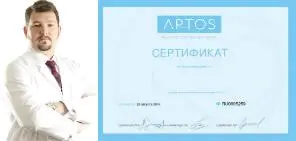
Certified doctors and clinics
Only doctors who have completed training at the APTOS School and received a certificate can perform APTOS thread lifting procedures.
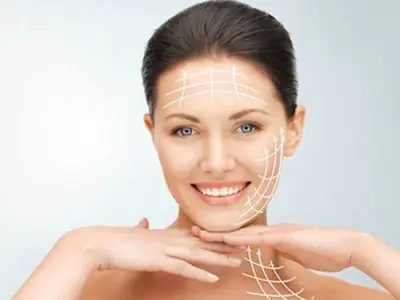
With age, natural aging processes occur in the skin and the question of how to restore its former elasticity and beauty becomes acute. Cosmetics do not always help, and the prospect of going under a surgical scalpel frightens many. In 1996, a non-surgical facelift method was invented, based on the use of special threads made from suture material.
The brand was named Aptos and today it is widely known in many countries around the world. It is a system of a thin injection needle-guide and a super-thin thread with notches that are located at a certain angle. These threads form a frame under the skin, and the notches fix the tissue in the desired position, modeling the contours. We will tell you about Aptos Excellence Visage and Nano Spring threads, show photos before and after the procedure, consider the features of rehabilitation immediately after reinforcement and tell you how to avoid complications.
Advantages of this technique
Benefits of thread lifting:
- A quick and pronounced effect that intensifies over time.
- Long lasting.
- There are no age restrictions.
- Minimally invasive.
Purposes of use
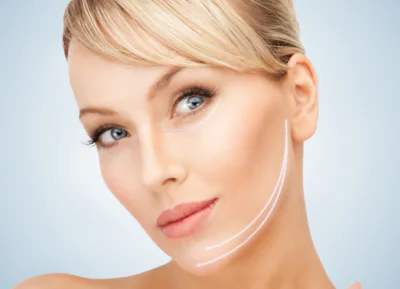
Facial correction. The thread lifting procedure allows you to model facial features and contours, correct asymmetry, and create a clear, beautiful oval.- Facelift. This method will help solve problems such as: ptosis, sagging tissue, longitudinal and transverse wrinkles on the forehead, wrinkles around the eyes, nasolabial folds, drooping eyebrows, sagging skin in the chin area, loose skin of the neck and décolleté.
- Rhinoplasty. Aptos threads can be used if it is necessary to correct the shape of the tip or wings of the nose. The rhinoplasty method allows you to create new tissue at the site where the threads are inserted, which will support the newly acquired contour of the nose.
Advantages: low trauma, quick recovery, quick results, the nose does not visually enlarge.
Disadvantages: the result is short-lived, the inserted threads can be visible visually, scars can form at the puncture sites, not all specialists know how to work in this direction.
Body correction. Thread lifting is an effective way to tighten the body without surgery.
We invite you to watch a video about the procedure using Aptos threads:
Features of the procedure
Manipulations are performed under local anesthesia. First, the doctor makes marks on the skin with a marker. Next, according to this marking, punctures are made. The puncture sites are usually located in inconspicuous places - behind the ears or under the hair near the temples.
Through the holes, needles (cannulas) are inserted into the subcutaneous layer, in which Aptos threads are fixed. Then the cannula is removed, the threads are carefully pulled up by the free ends, and then the ends are cut off. The procedure lasts on average 20-45 minutes, is carried out on an outpatient basis, hospitalization is not required.
We invite you to watch a video about how the procedure using Aptos threads works:
Efficiency
By physically tightening the tissue, using lactic acid and new collagen, the skin becomes smooth and toned, wrinkles, scars, cicatrices and other defects are smoothed out or completely disappear, facial features and contours are corrected.
We invite you to watch a video about the effectiveness of the procedure using Aptos threads:
More details about the effectiveness, technique of introducing Aptos threads and other nuances can be found in this material.
Photos before and after
Let's look at the results that can be achieved using Aptos threads for various cases.
These photos show the results of facial oval correction, neck and chin lift:
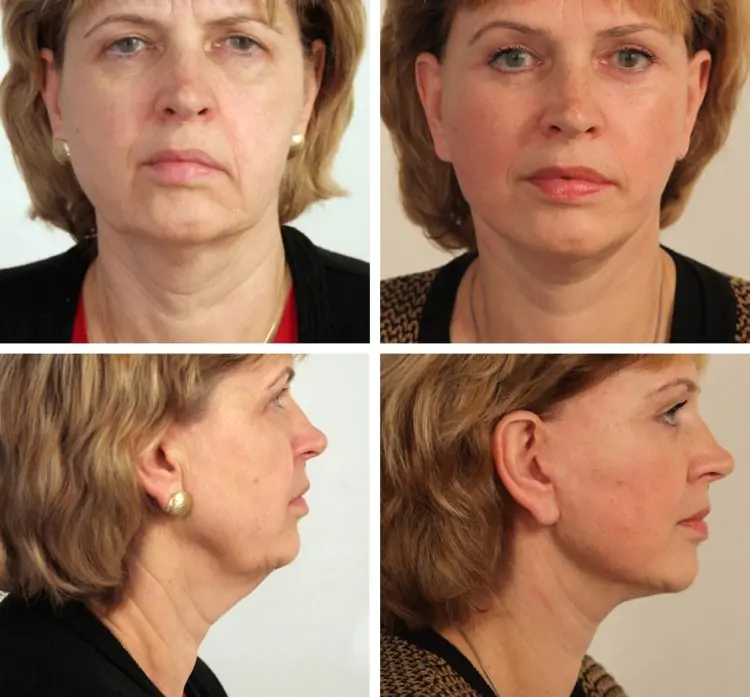
These photos show the results of a cheek lift to get rid of jowls.

Here is the face before and after the formation (raising) of the cheekbones:

Photos before and after lip correction, changing their shape:
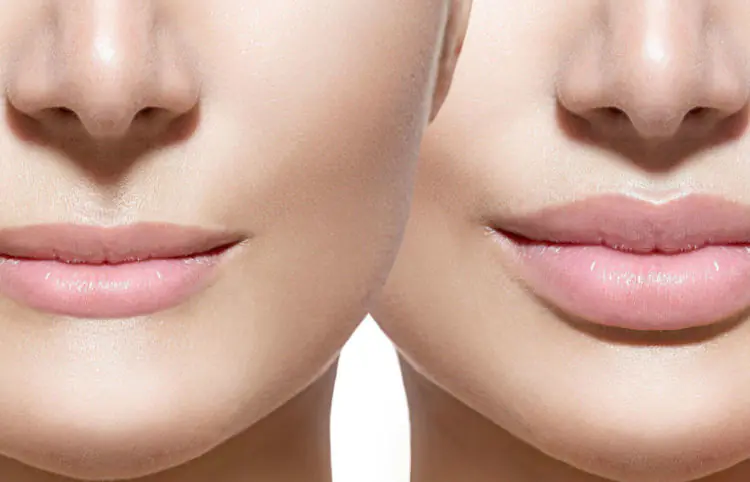
And in the photo below is a face before and after rhinoplasty with Aptos threads:
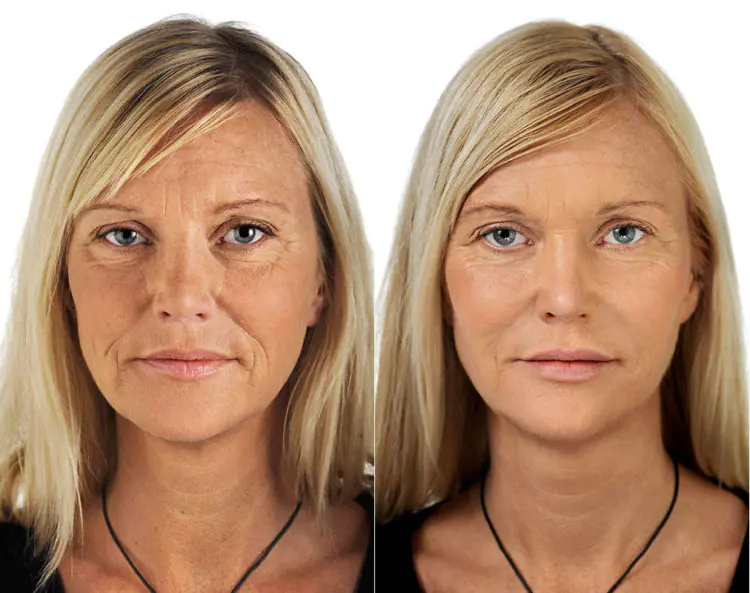
Types of material
There are different types of Aptos threads that are used for different purposes:
- "Hammocks" are used specifically to eliminate a double chin.
- "Springs" help fight nasolabial folds and sagging cheeks.
The most widely used products are:
- Aptos Excellence Visage threads — self-absorbing biothreads with notches provide a pronounced long-term effect.
- Aptos Excellence Visage Soft threads - biodegradable threads that are used to tighten small areas.
Threads from the Excellence Visage line successfully help solve the following problems:
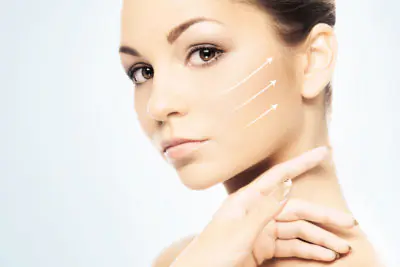
drooping upper eyelids and “sad” eyebrows;- deep wrinkles and creases in the skin on the face and neck;
- ptosis on the cheeks and chin;
- nasolabial folds.
The effect is noticeable immediately after the installation procedure and then goes on increasing. The final result appears in about a month and lasts for 3-5 years.
You can read more about what Aptos threads are and what types there are in this material.
Possible problems and their solutions
After this procedure, some undesirable consequences may occur.
Temporary Consequences
It should be noted that temporary effects usually do not require medical attention and go away on their own.
Temporary negative effects include:
Bruises. Bruises and small hematomas can occur due to damage to blood vessels.What to do? As a rule, they go away on their own; to speed up healing, you can use special ointments and gels - swelling.
Skin injury. The body's natural reaction to any injury.
What to do? They usually disappear in 10-14 days; medications can be used to speed things up.
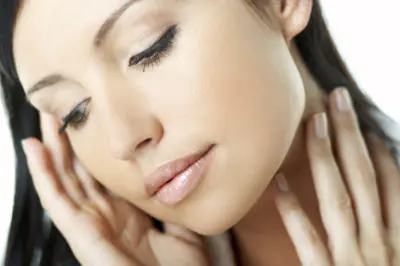
Skin disorders. Skin irregularities may occur where the needle is inserted and withdrawn.
What to do? In most cases, they go away on their own in about a week; if this does not happen, you should consult a doctor.
Facial disturbances. Violations of facial expressions are most often associated with the effects of anesthesia, in very rare cases - due to compression of the nerves.
What to do? If it does not go away for more than 3-4 days, you should consult a doctor.
Unnatural effect. The result of overcorrection is an overly pronounced effect, for example, overly prominent cheekbones, overly upturned eyebrows.
What to do? There is no need to do anything, it should go away naturally in 2-3 weeks.
We invite you to watch a video about what temporary phenomena may occur after implantation of Aptos threads:
Complications
- Contagion, infection. Infection due to improper preparation of the patient for surgery, lack of hygiene.
What to do? Antibiotics must be taken to fight the infection; in severe cases, the thread should be removed.
Allergic reactions. Allergies that can be caused by the anesthetic or skin treatment agent, very rarely, an allergy may occur to the material used.
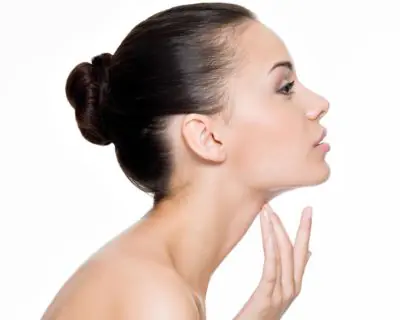
What to do: take antihistamines, in case of anaphylactic shock - administration of prednisolone, adrenaline, aminophylline, be sure to call an ambulance. If you are allergic to the threads themselves, they will have to be removed.
Disturbance of facial contour. This may occur if significant forces were applied when fixing the fabric to the thread.
What to do? Facial massage helps a lot. In difficult cases, it is necessary to remove the threads.
Thread migration. May occur when using smooth threads without a fixation system.What to do? Remove threads. Thread Bleeding. It is often the result of an error or violation of the injection technique.
What to do? Delete a fragment or the entire thread.
Rehabilitation period
The entire rehabilitation cycle after the procedure is divided into 3 stages.
Acute period (3-5 days). Fixing patches remain on the face, skin folds are very noticeable. It is recommended to sleep on your back, do not lie on your stomach or side, do not eat hot foods, do not support your head with your hands, do not open your mouth wide, chew slowly, without sudden movements, and do not actively use facial expressions. Physical activity, taking a hot shower, visiting a bathhouse, sauna, or swimming pool are contraindicated. The first day the puncture area is cooled with ice.When hematomas appear, it is recommended to use decongestants, such as Lyoton, Gepatrombin, Troxevasin, etc. If pain is present, taking painkillers is indicated. Also sometimes, in case of reduced immunity or with a large number of inserted threads, antibiotics are prescribed.
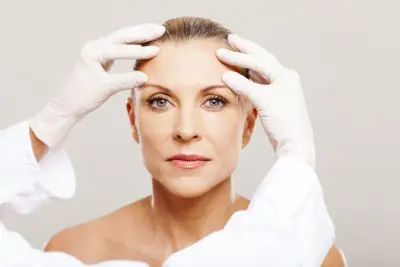
Early rehabilitation period (up to 2 weeks). The fixing patches are removed (either independently or with the help of a doctor). The folds are gradually straightened out. To speed up the rehabilitation process, you can use physiotherapy: ultrasound, iontophoresis, microcurrents. Masks with hyaluronic acid and creams with peptides also have a beneficial effect. Contraindications for the first period remain relevant, with the exception of visiting a hot shower. Drinking alcohol is also prohibited for 2 weeks. Late rehabilitation period (from 2 weeks to a month). The face takes on a normal appearance, the folds are almost invisible. It is still recommended to continue physical therapy and cosmetic rehabilitation to maintain the results. Contraindications to thermal procedures, massages and injections in the facial area remain (up to 2 months). Other restrictions are lifted. At the end of the period, you should make a follow-up visit to the doctor, who, if necessary, will correct residual defects.
We invite you to watch a video about rehabilitation after the procedure using Aptos threads:
Conclusion
Thus, Aptos thread lifting is an effective way to combat age-related skin changes, but at the same time, there is a risk of unpleasant consequences and complications.



